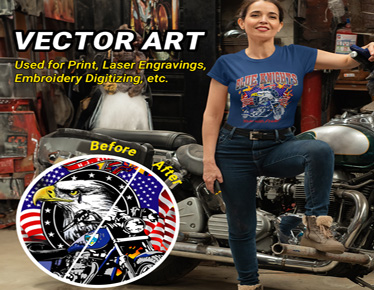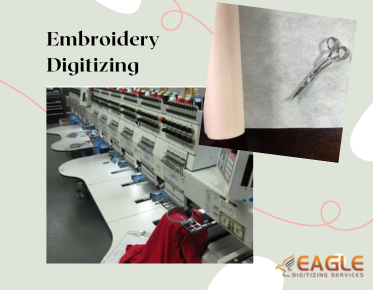What are the future trends of Vector Conversion Tools that you can't miss?
The Evolution of Vector
Conversion
In the ever-changing landscape of digital design, vector conversion tools have played a critical role in transforming how we create and manipulate images. From their humble beginnings to the sophisticated tools we use today, these technologies have evolved dramatically. But what's next on the horizon? As we look ahead, the future of vector conversion tools promises to bring even more innovative solutions, driven by advances in artificial intelligence, machine learning, and cloud computing.
Why
Vector Conversion Matters
From Pixels to Precision: The
Importance of Vector Graphics
Vector graphics have revolutionized the way we handle images,
turning pixelated, blurry visuals into crisp, scalable masterpieces. Unlike
raster images, which can lose clarity when resized, vector graphics maintain
their sharpness and detail no matter the scale. This precision is invaluable in
a world where visuals are used across various platforms and devices, from tiny
smartphone screens to massive billboards.
Industries That Rely on Vector
Conversion
Vector conversion isn't just a fancy tool for designers. It's a critical component in many industries. Marketing and advertising agencies rely on vectors for creating versatile logos and brand materials. The fashion industry uses vector graphics for intricate pattern designs. Architects and engineers depend on them for detailed plans and blueprints. Even the automotive and aerospace sectors utilize vector graphics for precision schematics and illustrations.
Current
State of Vector Conversion Tools
Popular Tools in Use Today
Today's market offers a plethora of vector conversion tools, each with
its own unique features and strengths. Software like Adobe Illustrator, CorelDRAW,
and Inkscape are staples in the design community, known for their robust
capabilities and user-friendly interfaces. Online tools like Vector Magic and
Autotracer have also gained popularity for their accessibility and ease of use.
Strengths and Limitations of
Existing Solutions
While these tools are powerful, they aren't without their limitations. Many desktop applications require significant processing power and memory, making them less accessible to users with lower-end hardware. Online tools, while convenient, often struggle with complex images and can lack the precision of their desktop counterparts. Additionally, the learning curve for some of these programs can be steep, presenting a barrier to entry for beginners.
Technological
Advances Shaping the Future
Artificial Intelligence: Smarter
Conversions
AI is set to revolutionize vector conversion by introducing smarter,
more efficient algorithms. These technologies can analyze images with greater
accuracy, identifying patterns and details that traditional methods might miss.
AI-driven tools can also automate tedious processes, freeing up designers to
focus on creativity rather than technical execution.
Machine Learning: Continuous
Improvement
Machine learning takes AI a step further by continuously learning from
user interactions and data. This means that the more a tool is used, the better
it becomes at predicting and addressing user needs. Future vector art conversion tools will be able to adapt to different styles
and preferences, offering personalized experiences that cater to individual
workflows.
Cloud-Based Solutions: Access
Anytime, Anywhere
Cloud computing is breaking down the barriers of traditional software. By hosting vector conversion tools in the cloud, users can access powerful features from any device, without worrying about hardware limitations. This shift not only enhances accessibility but also ensures that users always have the latest updates and features at their fingertips.
The
Role of AI in Vector Conversion
How AI Enhances Accuracy and
Efficiency
AI algorithms can process vast amounts of data quickly and accurately,
making them ideal for vector conversion. They can distinguish subtle
differences in color and shading, ensuring that the final vector graphic is as
close to the original image as possible. This leads to higher-quality outputs and
a more efficient conversion process.
Examples of AI-Powered Vector
Tools
Tools like Adobe Sensei and DeepArt.io are already leveraging AI to enhance their vector conversion capabilities. Adobe Sensei, for instance, uses machine learning to improve image trace functions, providing cleaner, more precise vectors. DeepArt.io uses neural networks to transform photos into vector-based artworks, showcasing the creative potential of AI.
Machine
Learning and Predictive Algorithms
Learning from User Data:
Personalizing Conversion
Machine learning enables tools to adapt to individual user preferences
by analyzing how they interact with the software. This personalized approach
can streamline workflows, as the tool learns to anticipate the user's needs and
adjust settings accordingly.
Future Capabilities of Machine
Learning in Vector Tools
As machine learning technologies advance, we can expect even more sophisticated capabilities. Future vector conversion tools might offer real-time suggestions and adjustments, helping users achieve their desired results faster. Predictive algorithms could also identify potential issues in an image before conversion, offering solutions to enhance quality.
Cloud
Computing and Its Impact
The Benefits of Cloud-Based
Vector Conversion
Cloud-based vector conversion offers numerous benefits, including
increased accessibility, collaborative features, and automatic updates. Users
can work from any device, share projects with teammates in real time, and
always have access to the latest tools and improvements.
Security and Accessibility in
the Cloud
Security is a major concern with any cloud-based solution. However, advancements in encryption and data protection are making it safer than ever to store and process sensitive information online. Users can rest assured that their data is secure while enjoying the convenience of cloud accessibility.
Integration
with Other Design Tools
Seamless Workflows: Connecting
Vector Tools with Design Software
Future vector conversion tools will integrate more seamlessly with
other design software, creating unified workflows that save time and reduce
friction. Imagine converting an image to vector format and instantly importing
it into your preferred design program without any compatibility issues.
Future Integrations to Watch For
We can expect future integrations to include direct links to 3D modeling software, animation tools, and even augmented reality platforms. These integrations will open up new possibilities for designers, allowing them to work across different media and formats effortlessly.
User
Experience: What’s Next?
Simplifying the Interface:
Making Conversion Intuitive
User experience is paramount, and future tools will focus on making
vector conversion as intuitive as possible. Simplified interfaces with guided
tutorials and smart suggestions will help users of all skill levels achieve
professional results without a steep learning curve.
Enhancing User Feedback and
Customization
Customization options will become more advanced, allowing users to tailor the tools to their specific needs. Enhanced feedback mechanisms will provide real-time insights, helping users understand how their actions impact the final vector graphic and how to make improvements.
The
Rise of Mobile Vector Conversion
Converting on the Go: Mobile
Apps and Their Potential
As mobile technology advances, vector conversion tools are becoming
available on smartphones and tablets. These mobile apps offer designers the
flexibility to work on projects anywhere, anytime, without being tied to a
desktop computer.
Challenges and Solutions for
Mobile Platforms
Mobile vector conversion tools face unique challenges, such as limited processing power and smaller screens. However, developers are finding innovative solutions, such as cloud processing and responsive interfaces, to overcome these obstacles and deliver powerful mobile experiences.
Open
Source Contributions and Collaborations
Community-Driven Innovations
The open-source community plays a crucial role in driving innovation
in vector conversion tools. Collaborative projects and shared resources lead to
continuous improvements and new features, benefiting all users.
The Power of Open Source in
Future Development
Open-source contributions ensure that vector conversion tools remain accessible and adaptable. They allow for rapid development and iteration, ensuring that these tools keep pace with the latest technological advancements and user needs.
Sustainability
and Eco-Friendly Computing
Energy-Efficient Algorithms
As concerns about environmental impact grow, developers are focusing
on creating energy-efficient algorithms. These sustainable practices not only
reduce the carbon footprint of software but also improve performance and reduce
costs.
Sustainable Practices in
Software Development
Sustainability in software development involves more than just energy efficiency. It includes using eco-friendly materials for hardware, promoting remote work to reduce commuting, and supporting digital recycling programs. These practices contribute to a more sustainable future for technology.
Anticipated
Features in Next-Gen Tools
Real-Time Conversion and Editing
Next-generation vector conversion tools will offer real-time conversion
and editing capabilities. Users will be able to see their changes instantly,
making the design process more dynamic and interactive.
Advanced Customization Options
Advanced customization options will allow users to fine-tune every aspect of their vector graphics. From precise control over paths and nodes to customizable color palettes and effects, these features will empower users to create exactly what they envision.
Addressing
Common User Pain Points
Improving Speed Without
Sacrificing Quality
One of the most common pain points is the time it takes to convert
images without losing quality. Future tools will leverage advanced algorithms
and faster processing power to deliver high-quality conversions quickly.
Handling Complex Images with
Ease
Handling complex images can be challenging, but future vector conversion tools will use sophisticated techniques to manage intricate details and patterns. This will enable users to convert even the most complex images with ease and accuracy.
Privacy
and Data Security Concerns
Ensuring User Data Protection in
Online Tools
Privacy and data security are paramount, especially for online tools.
Future vector conversion platforms will implement robust security measures to
protect user data, including encryption, secure login protocols, and regular
security audits.
Future Security Measures in
Vector Conversion
As cyber threats evolve, so too will security measures. Future vector conversion tools will stay ahead of potential vulnerabilities by incorporating advanced threat detection, automatic updates, and user education on best security practices.
The
Role of Feedback and User Data
Using User Insights to Drive
Improvements
User feedback is invaluable in driving the development of vector
conversion tools. By analyzing user data and feedback, developers can identify
areas for improvement and introduce new features that address real user needs.
The Future of User-Driven
Development
User-driven development will continue to shape the future of vector conversion tools. Community forums, beta testing programs, and direct user feedback channels will ensure that these tools evolve in ways that truly benefit their users.
Market
Trends and Predictions
Growth Projections for Vector
Conversion Tools
The market for vector conversion tools is set to grow significantly in
the coming years. As more industries recognize the value of vector graphics,
demand for advanced, user-friendly conversion tools will increase.
Emerging Markets and
Opportunities
Emerging markets, particularly in regions with growing digital economies, present new opportunities for vector conversion tool developers. Expanding into these markets can drive growth and innovation, catering to a broader range of users.
The future of vector conversion tools is
bright, with advances in AI, machine learning, and cloud computing paving the
way for more powerful, user-friendly solutions. As these tools continue to
evolve, they will empower designers to create with greater precision,
efficiency, and creativity. By embracing these innovations, we can look forward
to a future where vector conversion is seamless, accessible, and endlessly
inspiring.



